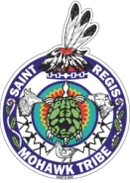-
Community & Family Services
- Care Management Program
- Child Support Enforcement Unit
- Family Support
- HCBS Waiver
- Home Improvement Supplement Program (HIP)
- Homeowner's Assistance Fund
- Individual Residential Alternatives (IRA)
- Individual Supports and Services (ISS) - Housing Subsidy Program
- Office of the Family Advocate
- Three Sisters Program
- Tribal Vocational Rehabilitation (TVR)
- Community Partnership Fund
- Economic Development
- Education
- Environment
- Executive Director's Office
- Finance
- Generations Park
- Grants & Contracts
-
Health Services
- A/CDP Outpatient
- A/CDP Prevention
- Partridge House (Inpatient)
- Ronthahiiohsthá:ke Clubhouse
- Business Office
- Centering Pregnancy
- Dental Clinic
- Health Promotion and Planning
- Laboratory
- Let's Get Healthy - Diabetes Center for Excellence
- Medical Clinic
- Mental Health - Kanikonri:ihne (Good Mind Counseling)
- Outreach Chronic Care Nursing
- Pharmacy
- School-Based Health Center
- Home Improvement Supplement Program (HIP)
- Human Resources
- Office for the Aging
- Office of Emergency Management and Safety
- Planning and Infrastructure
- Social Services Division
- Tribal Historic Preservation Office
- Tribal Police
For decades, three industrial facilities in Massena, New York have released hazardous substances to the St. Lawrence River environment. The facilities include Alcoa West, Alcoa East (the former Reynolds Metals Corporation), and the General Motors Central Foundry (together, the Facilities). Production wastes and associated contaminants (including, but not limited to, PCBs, PAHs, fluoride, and metals) from these Facilities were disposed of through outfalls into rivers and streams, in on-site disposal sites, and via aerial emissions. These contaminants were then transported throughout the environment via hydrological, aerial, and biological pathways, exposing and causing corresponding injury to natural resources. Some remediation of this contamination has occurred under the direction of the U.S. Environmental Protection Agency and the New York State Department of Environmental Conservation; additional remedial actions are ongoing.
A Trustee Council was formed to assess injuries and determine damages to the natural resources of the St. Lawrence Environment, and develop a plan for restoration of these injured natural resources. The Trustee Council consists of the U.S. Fish and Wildlife Service (on behalf of the U.S. Department of the Interior (DOI), the New York State Department of Environmental Conservation (on behalf of the State of New York), the National Oceanic and Atmospheric Administration (on behalf of the U.S. Department of Commerce), and the Saint Regis Mohawk Tribe, Environment Division (together, the Trustees).
The Trustees propose as compensation for ecological service losses, a suite of restoration projects that they expect will together provide additional ecological services of appropriate type and quality. The preferred types of restoration were selected from a larger list compiled from proposals received from Trustee agencies, the Companies, other government agencies, academics, nongovernmental organizations, and the general public, and were evaluated based on site specific and regulatory criteria (43 C.F.R. §11.82 (d)). Preferred alternatives include:
- Wetland Enhancement/Restoration,
- Streambank enhancement/restoration,
- Upland enhancement/restoration,
- Avian enhancement/restoration,
- Fisheries enhancement/restoration,
- Amphibian and reptile enhancement/restoration,
- Mammal enhancement/restoration, and
- Land conservation.
Points of Contact
| Saint Regis Mohawk Tribe (Administrative Trustee) | Tony David | tony.david@srmt-nsn.gov |
| New York State Dept. of Environmental Conservation | Randall Young | randall.young@dec.ny.gov |
| National Oceanic and Atmospheric Administration | James Turek | james.g.turek@noaa.gov |
| U.S. Fish and Wildlife Service | Dan Gefell | Daniel_Gefell@fws.gov |
| U.S. Fish and Wildlife Service | Ian Drew | ian_drew@fws.gov |
Settlement
When GM entered into bankruptcy in 2009, the Trustees filed a bankruptcy claim for natural resource liability and continued separate negotiations with Alcoa. On June 17, 2011, the courts approved the Consent Decree and settlement agreement resolving the GM bankruptcy claim brought by the Trustees. The Consent Decree with Alcoa is comprised of a cash payment of approximately $16.6 million for ecological and cultural restoration projects and past costs, implementation of five recreational fishing access projects, and purchase and legal transfer to NYSDEC of approximately 465 acres of property (near “Coles Creek” and “Wilson Hill”).
The Trustees are guided by a Restoration Compensations and Determination Plan and Environmental Assessment (RCDP). The purpose of an RCDP is to list possible alternatives for the restoration or rehabilitation of the injured natural resources, or the replacement and/or acquisition of equivalent natural resources. The RCDP describes in detail the resource injuries and associated losses, then outlines proposed restoration projects, specifically focusing on the Trustees’ priorities.
| General Motors Claim - 2011 Bankruptcy Settlement | $1.8M | Restoration plus assessment costs |
| Alcoa Claim - 2013 Settlement | $8.3M | Ecological restoration projects |
| $1.8M | Lost fishing/boating access | |
| $8.4M | Cultural restoration projects | |
| Trustee agency assessment costs | ||
| $20.3M |

